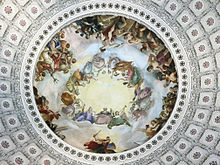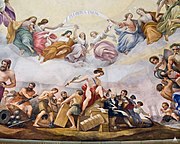art.wikisort.org - Painting
The Apotheosis of Washington is the fresco painted by Greek-Italian artist Constantino Brumidi in 1865 and visible through the oculus of the dome in the rotunda of the United States Capitol Building. The fresco is suspended 180 feet (55 m) above the rotunda floor and covers an area of 4,664 square feet (433.3 m2). The figures painted are up to 15 feet (4.6 m) tall and are visible from the floor below. The dome was completed in 1863, and Brumidi painted it over the course of 11 months at the end of the Civil War. He was paid $40,000 ($708,087 in today's funds[1]) for the fresco.


Brumidi had worked for three years in the Vatican under Pope Gregory XVI, and served several aristocrats as an artist for palaces and villas, including the prince Torlonia. He immigrated to the United States in 1852, and spent much of the last 25 years of his life working in the Capitol. In addition to The Apotheosis of Washington he designed the Brumidi Corridors.
Symbolism

The Apotheosis of Washington depicts George Washington sitting amongst the heavens in an exalted manner, or in literary terms, ascending and becoming a god (apotheosis). Washington, the first U.S. president and commander-in-chief of the Continental Army during the American Revolutionary War, is allegorically represented, surrounded by figures from classical mythology. Washington is draped in purple, worn by generals of the ancient Roman Republic during their triumphs, with a rainbow arch at his feet, flanked by the goddess Victoria (draped in green, using a horn) to his left and the goddess of Liberty to his right. Liberty wears a red liberty cap, symbolizing emancipation, from a Roman tradition where slaves being manumitted would be given a felt cap (Latin pileus). She holds a fasces in her right hand and an open book in the other, to which Washington gestures with his right hand.
Forming a circle between Liberty and Victory are 13 maidens, each with a star above her head, representing the original 13 colonies. Several of the maidens have their backs turned to Washington, said to represent the colonies that had seceded from the Union at the time of painting. Across the circle from Washington is the banner E Pluribus Unum meaning "out of many, one".
Surrounding Washington, the two goddesses and the 13 maidens are six scenes lining the perimeter, each representing a national concept allegorically: from directly below Washington in the center and moving clockwise, "War," "Science," "Marine," "Commerce," "Mechanics," and "Agriculture". The perimeter scenes are not fully visible from the floor of the Capitol.
| Scene | Description |
|---|---|
 |
War Freedom, also known as Columbia, is directly below Washington in the personification of War. The scene depicts a woman fighting for liberty with a raised sword, a cape, and a helmet and shield (in the colors of the U.S. flag) trampling figures representing Tyranny and Kingly Power. To Freedom's left assisting her is a fierce bald eagle (the national bird of the United States) carrying arrows and a thunderbolt (reminiscent of the arrows carried by the eagle in the Great Seal of the United States). |
 |
Science Minerva, the Roman goddess of crafts and wisdom, is portrayed with helmet and spear pointing to an electrical generator creating power stored in batteries next to a printing press, representing great U.S. inventions. U.S. scientists and inventors Benjamin Franklin, Samuel F. B. Morse, and Robert Fulton watch. In the left part of the scene a teacher demonstrates the use of dividers. |
 |
Marine This scene shows Neptune, the Roman sea-god, with trident and crown of seaweed riding in a shell chariot drawn by sea horses. Venus, goddess of love born from the sea, is depicted helping to lay the transatlantic telegraph cable which ran from North America to the Telegraph Field in Ireland.[2] In the background is an ironclad warship with smokestacks. |
 |
Commerce Mercury, the Roman god of commerce, with his winged petasos and sandals and a caduceus, is depicted giving a bag of gold to American Revolutionary War financier Robert Morris. To the left, men move a box on a dolly; on the right, the anchor and sailors lead into "Marine." |
 |
Mechanics Vulcan, the Roman god of fire and the forge, is depicted standing at an anvil with his foot on a cannon next to a pile of cannonballs. A steam engine is in the background. The man at the forge is thought to represent Charles Thomas, the supervisor of ironwork during the construction of the Capitol dome. |
 |
Agriculture Ceres, the Roman goddess of agriculture, is shown with a wreath of wheat and a cornucopia, symbol of plenty, while sitting on a McCormick mechanical reaper. The personification of Young America in a liberty cap holds the reins of the horses, while the goddess Flora gathers flowers in the foreground. |
See also
- American civil religion
- Apotheosis
- Panthéon, Paris – building with a dome fresco titled The Apotheosis of Saint Genevieve
- George Washington (Greenough)
References
- 1634–1699: McCusker, J. J. (1997). How Much Is That in Real Money? A Historical Price Index for Use as a Deflator of Money Values in the Economy of the United States: Addenda et Corrigenda (PDF). American Antiquarian Society. 1700–1799: McCusker, J. J. (1992). How Much Is That in Real Money? A Historical Price Index for Use as a Deflator of Money Values in the Economy of the United States (PDF). American Antiquarian Society. 1800–present: Federal Reserve Bank of Minneapolis. "Consumer Price Index (estimate) 1800–". Retrieved April 16, 2022.
- buchanan-solutions.com. "Valentia Island, Ireland". The Telegraph Field. Archived from the original on 2013-06-21. Retrieved 2013-07-02.
External links
- The Apotheosis of Washington, Architect of the Capitol.
- The Apotheosis of George Washington : Brumidi's fresco & Beyond, The University of Virginia.
- The Telegraph Field : Valentia Island, Ireland.
- Figure 49. Study for the Apotheosis of George Washington, c. 1863 (photo), Irma B. Jaffe (1992). The Italian presence in American art, 1860-1920. Fordham Univ Press. pp. 85. ISBN 978-0-8232-1342-9.
- apotheosisofwashington.com, dedicated website with interactive panorama view
- Presidents Day and the Apotheosis of Washington, Online Library of Liberty
На других языках
[de] The Apotheosis of Washington
The Apotheosis of Washington, (deutsch Die Apotheose Washingtons) ist ein im Jahre 1865 gemaltes Fresko des italienischen Künstlers Constantino Brumidi. Es befindet sich in etwa 55 Metern Höhe in der Spitze der Kuppel der Rotunde des Kapitols der Vereinigten Staaten. Brumidi malte das 433,3 m² große Fresko in elfmonatiger Arbeitszeit unmittelbar nach Ende des Sezessionskriegs.- [en] The Apotheosis of Washington
[it] L'Apoteosi di George Washington
L'Apoteosi di Washington è un affresco dell'artista italo-greco Constantino Brumidi, realizzato nel 1865 per il Governo federale degli Stati Uniti d'America.[ru] Апофеоз Вашингтона
«Апофео́з Ва́шингтона» (англ. The Apotheosis of Washington) — фреска работы греко-итальянского художника Константина Брумиди, написанная в 1865 году и наблюдаемая через окулюс купола ротонды Капитолия США. Фреска расположена на высоте 55 м от пола ротонды и занимает площадь в 433,3 м². Фигуры изображены в высоту до 4,6 м и видны с этажа ниже. Строительство купола было завершено в 1863 году; Брумиди написал фреску в течение 11 месяцев в конце Гражданской войны. За написание фрески ему заплатили 40 тысяч долларов.Другой контент может иметь иную лицензию. Перед использованием материалов сайта WikiSort.org внимательно изучите правила лицензирования конкретных элементов наполнения сайта.
WikiSort.org - проект по пересортировке и дополнению контента Википедии


